Maintaining a high-performance bicycle is crucial for achieving optimal speed and efficiency. Key techniques include regular drivetrain cleaning, tire pressure checks, and proper lubrication. Additionally, inspecting brakes and gears ensures safety and smooth operation. Tailoring maintenance to specific bicycle types further enhances performance and longevity.
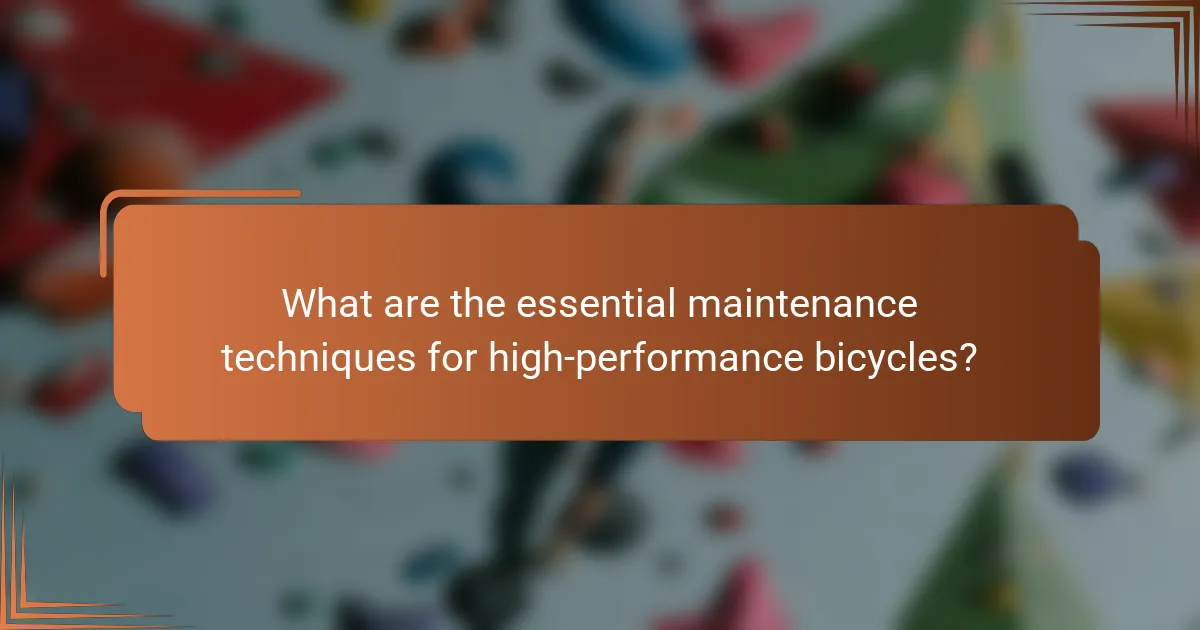
What are the essential maintenance techniques for high-performance bicycles?
Regular maintenance ensures high-performance bicycles operate optimally. Key techniques include cleaning the drivetrain, checking tire pressure, lubricating components, and inspecting brakes and gears.
1. Clean the drivetrain weekly to remove dirt and debris. This prevents wear and improves efficiency.
2. Check tire pressure before each ride. Optimal pressure enhances grip and reduces rolling resistance.
3. Lubricate the chain and moving parts every few rides to ensure smooth operation and prevent rust.
4. Inspect brakes and gears regularly. Ensure they function correctly for safety and performance.
5. Perform a thorough check of the frame and components for any signs of damage or wear. Address issues promptly to maintain performance.
How often should you perform routine maintenance?
Perform routine maintenance on a high-performance bicycle every 1 to 3 months, depending on usage. Regular checks ensure optimal performance and longevity. For daily riders, monthly inspections are ideal, focusing on tire pressure, brake function, and chain lubrication. For occasional cyclists, a quarterly schedule may suffice. Consistent maintenance prevents wear and enhances safety, ensuring a smooth ride.
What tools are necessary for effective bicycle maintenance?
Essential tools for effective bicycle maintenance include a multi-tool, tire levers, a floor pump, and a chain cleaner. These tools help ensure optimal performance and longevity of the bicycle. A multi-tool typically features various wrenches and screwdrivers, allowing for quick adjustments. Tire levers assist in changing flat tires efficiently. A floor pump provides the necessary pressure for tires, while a chain cleaner maintains the drivetrain’s cleanliness and efficiency. Regular use of these tools can enhance the bicycle’s overall performance and reliability.
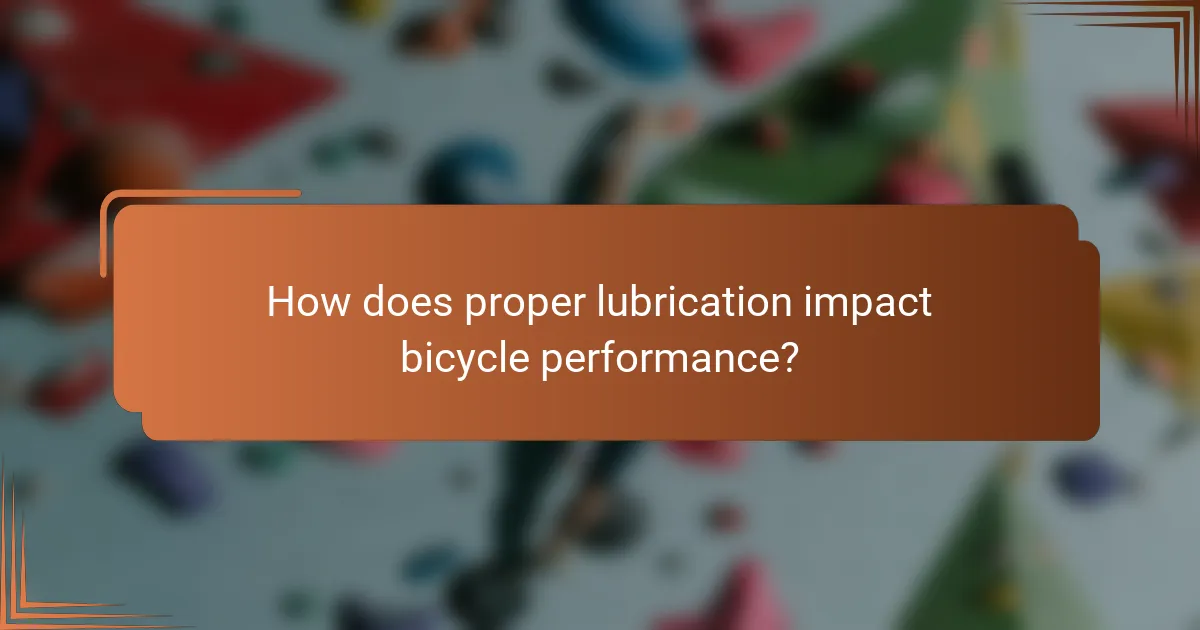
How does proper lubrication impact bicycle performance?
Proper lubrication significantly enhances bicycle performance by reducing friction and wear. This leads to smoother gear shifts, improved pedaling efficiency, and extended component lifespan. Regular maintenance with appropriate lubricants can optimize these benefits, ensuring consistent performance on varied terrains. For instance, a well-lubricated chain can improve energy transfer by up to 98%, highlighting lubrication’s critical role in high-performance cycling.
Which parts of the bicycle require lubrication?
Key parts of a bicycle requiring lubrication include the chain, derailleurs, brake pivots, and hub bearings. Regular lubrication enhances performance and extends component lifespan.
1. Chain | Essential for smooth gear shifting and reducing wear.
2. Derailleurs | Ensure precise gear changes; lubrication prevents sticking.
3. Brake pivots | Smooth operation of brakes is vital for safety.
4. Hub bearings | Reduce friction for efficient wheel rotation.
5. Bottom bracket | Lubrication aids in crank movement and pedal efficiency.
6. Cables and housing | Reduces friction for better shifting and braking response.
What types of lubricants are best for high-performance bicycles?
Silicone-based, Teflon-based, and wax-based lubricants are best for high-performance bicycles. Silicone lubricants provide excellent water resistance and durability. Teflon lubricants offer low friction and smooth operation. Wax-based options reduce dirt accumulation, enhancing performance.
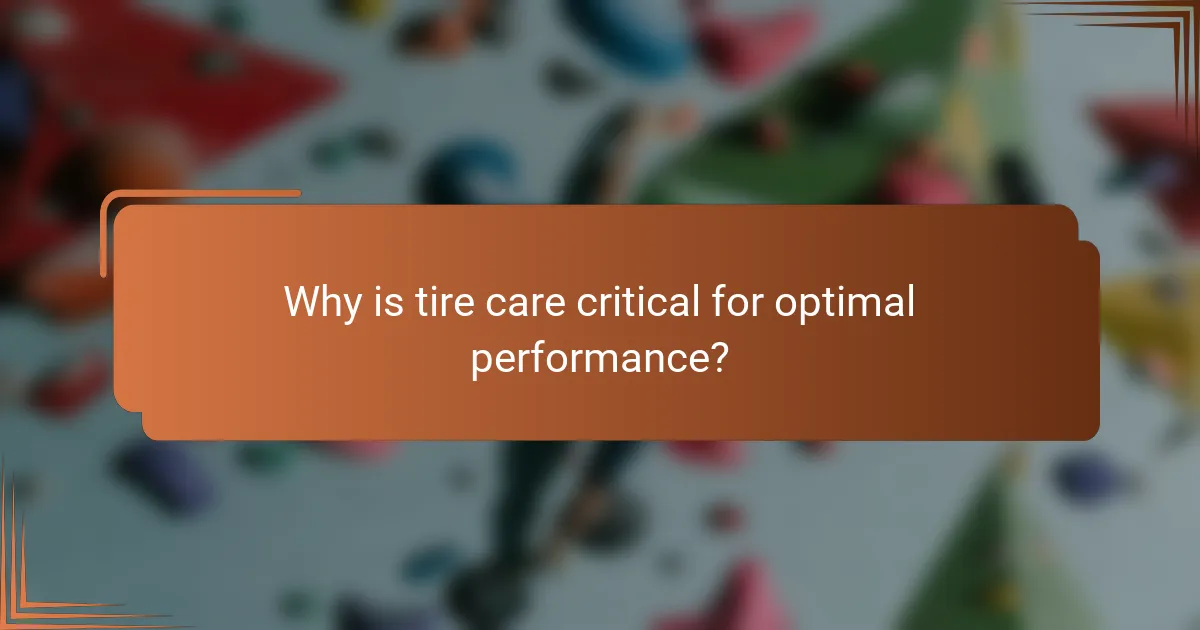
Why is tire care critical for optimal performance?
Tire care is critical for optimal performance as it directly affects handling, safety, and efficiency. Proper inflation, tread depth, and alignment enhance traction and reduce rolling resistance. Regular inspections can prevent blowouts and extend tire lifespan. Maintaining tires ensures a smoother ride and better energy use, crucial for high-performance bicycles.
How do you check tire pressure accurately?
To check tire pressure accurately, use a reliable pressure gauge and ensure tires are cold. Remove the valve cap, press the gauge onto the valve stem, and read the measurement. Compare it to the recommended pressure listed on the bike frame or in the owner’s manual. Regular checks enhance performance and safety.
What are the signs of tire wear and when should you replace them?
Signs of tire wear include visible tread wear, cracks, bulges, and uneven wear patterns. Replace tires when tread depth is less than 1/16 inch or when any of these signs are present. Regular inspection ensures optimal performance and safety.
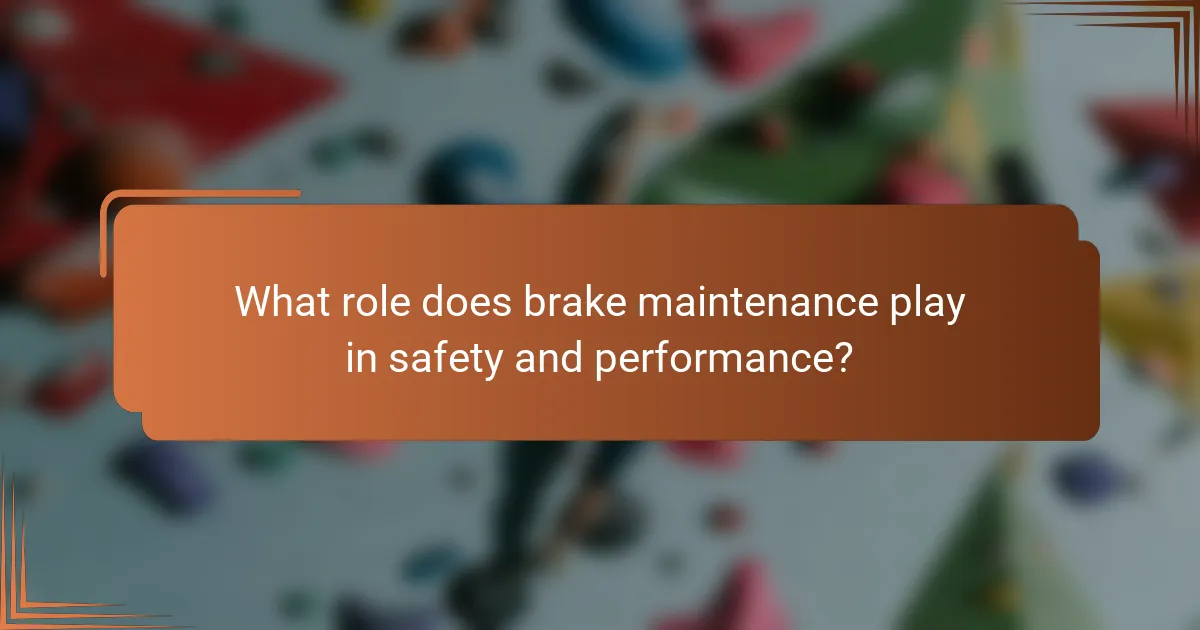
What role does brake maintenance play in safety and performance?
Brake maintenance is crucial for ensuring both safety and performance in high-performance bicycles. Regularly checking and adjusting brakes enhances stopping power, reduces wear, and prevents accidents. Properly maintained brakes improve overall riding efficiency and responsiveness, allowing cyclists to perform optimally in various conditions. Neglecting brake maintenance can lead to decreased performance and increased risk of failure, impacting rider safety.
How can you tell when brake pads need replacing?
Brake pads need replacing when they show significant wear, usually indicated by a thickness of less than 3 millimeters. Additionally, listen for squeaking or grinding noises during braking. Check for vibrations or reduced braking efficiency as these are signs of worn pads. Regular inspections help maintain optimal performance and safety.
What are the steps to properly adjust brake systems?
To properly adjust brake systems on high-performance bicycles, follow these steps:
1. Inspect brake pads for wear and alignment.
2. Adjust the brake lever reach for comfortable grip.
3. Align brake calipers with the wheel rim.
4. Ensure proper cable tension for responsive braking.
5. Test the brakes and make final adjustments as needed.

Which unique maintenance considerations exist for different bicycle types?
High-performance bicycles require specific maintenance techniques to ensure optimal performance. Different types of bicycles, such as road, mountain, and hybrid bikes, have unique maintenance considerations.
Road bikes often need frequent tire pressure checks and regular chain lubrication due to their lightweight design. Mountain bikes require more attention to suspension systems and brake adjustments because of their rugged use. Hybrid bikes benefit from a balanced approach, focusing on tire wear and drivetrain cleanliness.
Each bicycle type’s unique attributes dictate tailored maintenance schedules. For instance, road bikes typically have a higher frequency of maintenance due to their speed-focused components, while mountain bikes may require specialized tools for suspension tuning. Understanding these differences enhances overall bicycle longevity and performance.
How do maintenance needs differ between road and mountain bikes?
Maintenance needs differ significantly between road and mountain bikes due to their distinct designs and usage. Road bikes require more frequent tire pressure checks and drivetrain cleaning, while mountain bikes need regular suspension maintenance and frame inspection for wear.
Road bikes typically have lighter components, demanding precise adjustments for optimal performance. In contrast, mountain bikes face harsher conditions, necessitating robust parts and more frequent checks for dirt and debris.
Key differences include:
| Attribute | Road Bikes | Mountain Bikes |
|——————–|——————————-|——————————-|
| Tire Pressure | High pressure (80-130 psi) | Lower pressure (30-50 psi) |
| Drivetrain Care | Frequent cleaning required | Regular checks for dirt |
| Suspension Maintenance | Minimal, if any | Regular servicing essential |
| Frame Inspection | Less frequent | Frequent due to rough terrain |
What specific care do electric bicycles require?
Electric bicycles require regular maintenance to ensure optimal performance. Key care tasks include battery management, tire maintenance, brake checks, and drivetrain inspections.
1. **Battery Management**: Regularly charge the battery and monitor its health to maintain a capacity of around 450 Wh.
2. **Tire Maintenance**: Check tire pressure weekly to keep it within the recommended range, typically 40-65 psi.
3. **Brake Checks**: Inspect brake pads for wear and replace them when they are less than 1/8 inch thick.
4. **Drivetrain Inspections**: Clean and lubricate the chain every 100 miles to prevent wear and ensure smooth operation.
These practices enhance longevity and performance, ensuring a safe and enjoyable riding experience.
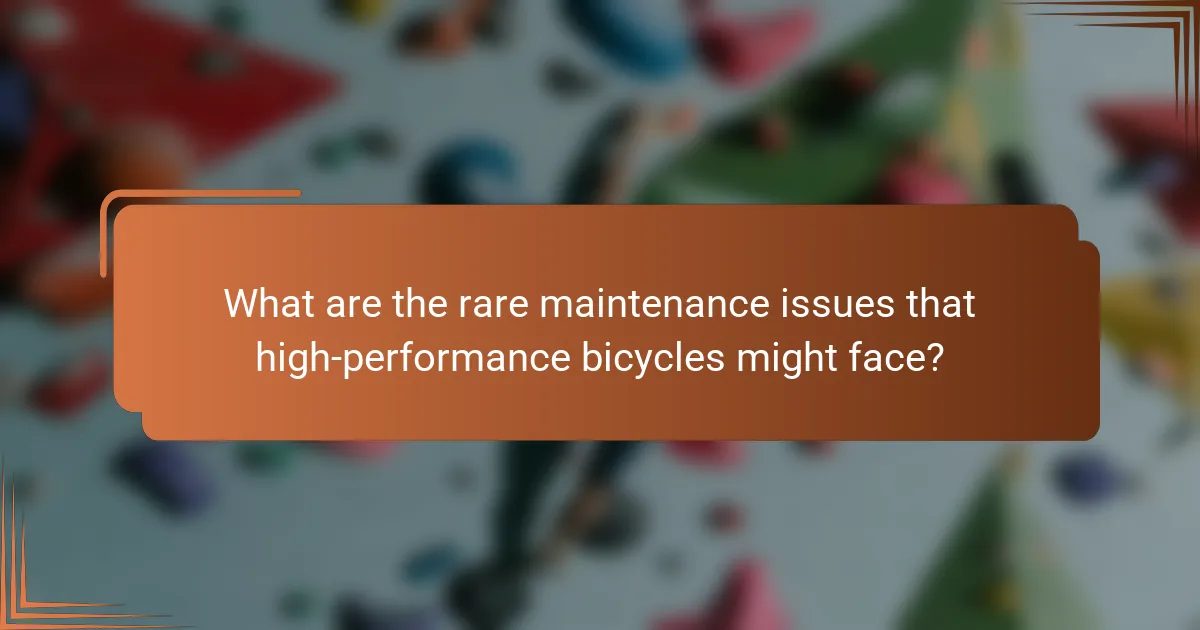
What are the rare maintenance issues that high-performance bicycles might face?
High-performance bicycles may face rare maintenance issues such as frame cracking, wheel misalignment, and electronic component failures. These problems often arise from extreme stress, improper adjustments, or environmental factors. Addressing these issues promptly ensures optimal performance and safety. Regular inspections and maintenance can help detect these rare problems before they escalate.
How do you diagnose and fix unusual noises while riding?
To diagnose and fix unusual noises while riding, inspect the bike’s components systematically. Start with the wheels, checking for loose spokes or misaligned brakes. Examine the drivetrain for worn-out chains or derailleurs. Listen for sounds from the bottom bracket and headset, which may indicate wear. Tightening or replacing components as needed will resolve most issues. Regular maintenance can prevent these noises from occurring.
What should you do if the bicycle frame is damaged?
If the bicycle frame is damaged, assess the extent of the damage first. For minor issues, such as scratches or small dents, consider using touch-up paint or frame repair kits. For significant damage, like cracks or bends, consult a professional for repairs or consider replacing the frame. Regular inspections can prevent serious issues.
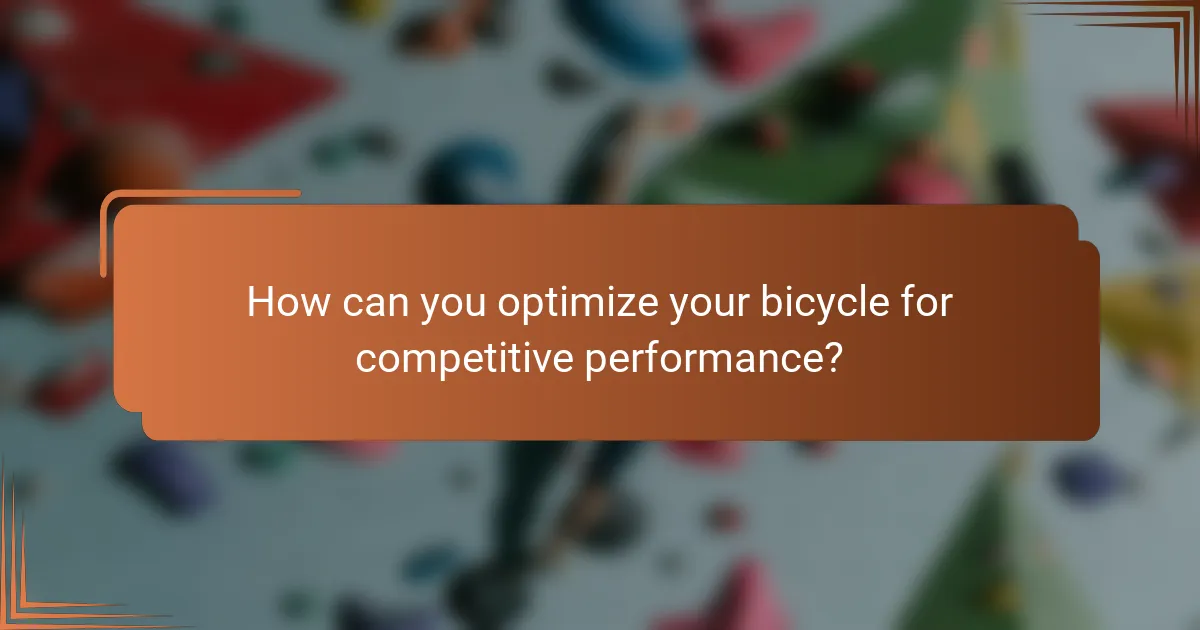
How can you optimize your bicycle for competitive performance?
To optimize your bicycle for competitive performance, focus on regular maintenance, component upgrades, and precise adjustments. Consistent tire pressure, clean drivetrain, and properly lubricated parts enhance efficiency.
1. Maintain tire pressure within optimal range (typically 90-120 psi) for reduced rolling resistance.
2. Regularly clean and lubricate the chain to ensure smooth shifting and prolong component life.
3. Upgrade to lightweight components, such as carbon handlebars or high-performance wheels, to improve power-to-weight ratio.
4. Adjust the bike fit to ensure optimal comfort and aerodynamics, enhancing overall performance.
5. Regularly check brake performance and replace worn pads to maintain safety and efficiency.
What modifications can enhance speed and efficiency?
Regular maintenance, proper adjustments, and upgrades can significantly enhance the speed and efficiency of a high-performance bicycle. Key modifications include optimizing tire pressure, ensuring proper chain lubrication, and fine-tuning gear adjustments.
Upgrading components like wheels or gears can also contribute to improved aerodynamics and reduced weight, enhancing overall performance. Regularly checking brake alignment and reducing friction in moving parts further supports efficient operation.
Which performance upgrades provide the best return on investment?
Upgrading components like tires, brakes, and gearing systems provides the best return on investment for high-performance bicycles. These enhancements significantly improve speed, handling, and safety. For example, high-quality tires can reduce rolling resistance, while advanced brake systems enhance stopping power. Upgrading these elements can lead to a noticeable performance boost without extensive costs.
What are the best practices for maintaining a high-performance bicycle?
To maintain a high-performance bicycle, focus on regular cleaning, lubrication, and checking components. Proper maintenance enhances performance and prolongs the bike’s lifespan.
1. Clean the frame and components regularly to remove dirt and grime.
2. Lubricate the chain and moving parts to ensure smooth operation.
3. Inspect tires for wear and maintain proper inflation levels for optimal traction.
4. Check brakes for responsiveness and replace pads as needed.
5. Regularly tune gears to ensure accurate shifting and performance.
6. Store the bicycle in a dry place to prevent rust and corrosion.